Collections – Diecast planes
Diecast planes have a very similar history to diecast vehicles. This is largely because it involves many of the same manufacturers (as their background and origins was covered under Diecast Vehicles it may be more helpful to read that first).
Please click here to visit the Diecast vehicles page
The first heavier than air or powered flight was made by the Wright Brothers in 1903 at Kittyhawk, North Carolina, USA. However, aviation based toys – based on balloons and dirigibles (airships) – were available from at least the 1890s.
The first metal aircraft toys were made from tinplate (more diecut than diecast – the metal shapes being cut out of metal sheets rather than cast from moulds). The market was dominated by German companies like Marklin, Bing, Gunthermann (although, like in the case of postcards, sentiment turned against them in Britain with the outbreak of WWI).
Even though these makers were producing aircraft toys as early as 1909, they weren't just for static display – some had wind-up rubberbands or a clockwork mechanism that powered the propeller, so they could either taxy under their own power or 'fly' along a stretched wire or string.
Credit for diecast aircraft goes to the same people who pioneered diecast vehicles – the American firm Tootsietoy, who added aircraft to their diecast range in the 1920s.
Around 1931 – the same time Britain's Meccano Limited launched their Modelled Miniatures (also known as Meccano Miniatures, which later became Dinky Toys in 1934), they also released a series of Meccano aircraft construction kits. That same year Line Brothers founded International Model Aircraft Limited (please see box below).
However, it was the Dinky range of diecast aircraft, first launched in late 1934, that is of particular interest to Hatfield aviation enthusiasts and diecast collectors as it featured de Havilland and Airspeed designs (some pictured below).
The very first Dinky diecast aeroplanes released was a boxed set of six (according to the online UK Civil Aircraft Register some of the registrations used on these diecasts were for different aircraft types or were first registered after the diecast versions were released, which suggests that some registrations were either reused or were made up).
Imperial Airways Liner (No. 60A) – bearing registration letters G-ABTI. It was modelled on Armstrong Whitworth AW.15 Atlanta, serial AW742, registered 14 January 1932.
Leopard Moth (No. 60B) – bearing registration letters G-ACPT (the register indicates this was a de Havilland DH.60G III Moth Major – not a DH.85 Leopard Moth – registered on 18 June 1937). The very first DH.85 Leopard Moth, G-ACHD, made its first flight from Stag Lane, piloted by Capt Geoffrey de Havilland, on 27 May 1933. A few weeks later he won the King's Cup Air Race at Hatfield in it. Production of the DH.85 transferred to Hatfield the next year, and 132 were built in three years.
Percival Gull (No. 60C) – bearing registration letters G-ADZO. The registration matches a Percival Gull Six owned by Amy Mollison (nee Johnson), and later by Harold Leslie Brook (an Australian). Both used this aircraft to establish new flight records, and both pilots are known to have visited Hatfield.
Low Wing Monoplane (No. 60D) – bearing registration letters G-AVYP. Said to have been modelled on the Vickers Jockey.
General Monospar (No. 60E) – bearing registration letters G-ABVP. Registration matches a General Aircraft Limited GAL ST4 Monospar Mk.I, registered to Alfred Charles Morris Jackaman on 21 May 1932. He took part in the 1933 and 1934 King's Cup air races, held at Hatfield, in this aircraft. Unfortunately, he failed to start in Heat 3 in the 1933 race and was eliminated. He didn't fare much better the following year and failed to make the second round of the race (which was ultimately won by F/Lt H M Schofield in a Monospar ST.10).
Cierva Autogiro (No. 60F) – unfortunately this appears to have been released without any registration markings, which is a shame as at least one example of this type of aircraft (appears to be a C.30) has taken part in a flight demonstration at Hatfield. A different version, the C.24 (G-ABLM), was designed and built by de Havillands, and first flew at Stag Lane. It was restored by Hawker Siddeley apprentices at Hatfield in 1973-74.
Incidentally, the Dinky numbering system started with their forerunner, Modelled Miniatures, in 1931 with No. 1A. In the 1950s, there was a major change to the system and toys were placed in ranges with three digits: 700-749 being aeroplanes; 900-999 used for larger Dinky Supertoys.
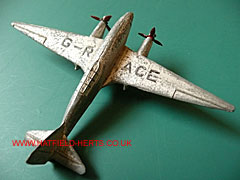
Dinky Toys 'Light Racer' (60G) – bearing registration G-RACE. Modelled on the DH.88 Comet Racer which was designed for and won the London to Australia (Melbourne Centenary) air race in 1934. Although the diecast is marked 'Light Racer' and uses a fake registration (the race was won in red-painted G-ACSS) the link is clear – as the 1936 Meccano Dinky ad below shows. The somewhat beaten up look ('distressed' in antiques terms) is not uncommon in children's diecast toys and is described as 'playworn'. Collectors usually want as close to factory finish (mint) condition as possible. However, even in a playworn condition rare items can still be worth large sums.
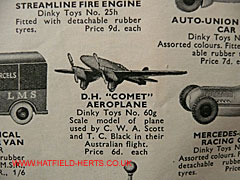
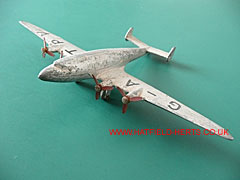
Dinky Toys 'Four Engined Liner' (62R) – bearing registration G-ATPV. Modelled on the DH.91 Albatross, which was designed, built and made its first flight from Hatfield on 20 May 1937. Only seven were made, none had this registration. Dinky later released this as 62W with the registration G-ADJI, which was the registration for DH.91 6802 'Frobisher'.
In all, before production ceased during WWII, Dinky Toys' early range featured over 35 different aircraft. Dinky Toys' French operations also released some early aircraft, like the Potez 56.
Line Brothers – toy making in the blood
The Lines Family's involvement in toy making in Britain dates back to around 1850. In their early days they made wooden toys, like rocking horses.
G & J Lines was founded by brothers George and Joseph in 1876 but they are not the Line Brothers that are of particular interest to diecast and aviation toy fans. They were Joseph's sons – William, Arthur and Walter.
In 1919, returning back home after military service in WWI, the three brothers decided to set up their own firm, which they did later that year. This was the beginning of Lines Brothers Limited.
By 1921 they had brought premises in London.
By 1924 they were employing over 500 people. That same year they registered Tri-Ang Toys as their trademark (which was something of a family joke – everyone knows you need three lines to make a triangle).
In 1931, employing over 1,000 people, they bought the famous Regent Street toy shop, Hamleys. They also founded International Model Aircraft Limited. If that wasn't enough they registered Pedigree – a separate doll-making concern.
In 1933, they floated the company on the stock market.
In 1935 they launched the MINIC range of diecast vehicles as a competitor to Frank Hornby's Dinky Toys.
During WWII, toy production ceased and the factory machines turned out munitions
The date is not clear but at some stage the company also acquired a bicycle and tricycle making company in Birmingham.
International Model Aircraft Limited created a range of flying model aircraft sold under the name FROG (Flies Right Off the Ground). While they appear more diecut than diecast they are still worthy of a mention. Their 1937/38 catalogue featured a number of de Havilland aircraft, like the DH Puss Moth (shown below in a 1934 ad).
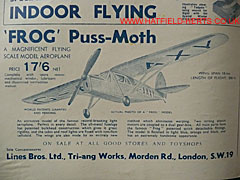
After the war the company (or more accurately the group) went from strength to strength. They bought companies far and wide – including Mini Models, which had launched Scalextrics in 1952. In 1962, Pedigree launched Sindy as a competitor to Mattel's Barbie doll.
Although the company's fortunes are a worthy story it is too long to go into further here. However, perhaps their crowning glory was buying Meccano Limited (including Dinky Toys) in 1964. Sadly, the company, once the world's largest toy maker and renown for its Tri-Ang model railways, ran out of steam in 1971 and was largely broken up and sold off.
Diecast toys were revived after the war and experienced a second 'golden age' between the 1950s and '70s. However, the Oil Embargo of the 1970s and the advent of electronic toys meant the end of their glory days.
Corgi started The Aviation Archive collection in 1997, and its success revived the flagging fortunes of diecast aircraft. The boys who once played with the original toy planes, that cost pocket money prices, were now grown up and willing to pay serious money for accurate replicas of famous planes (particularly those related to famous pilots), and even more for mint condition toys of their youth. Naturally, accuracy and detail were improved. Corgi's success has meant a revival in the market for diecast planes – marketed now as collectors items (but it probably is a safe bet that when no one else is looking yesterday's child comes out to play).
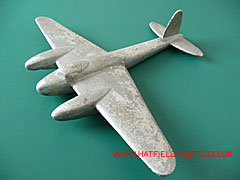
DH.98 Mosquito – bears no maker's name or registration marks. It's probably not even diecast. Its crude nature and general lack of detail suggests that it was handcrafted. It is possible that this was made by a de Havilland metal worker out of metal scraps from the real Mosquito, probably as toy for a child during the war. However, given the lack of any documentation it's impossible to say for certain (although metallurgical tests should be able to reveal whether it is made from the same alloy used for parts like the propellers).
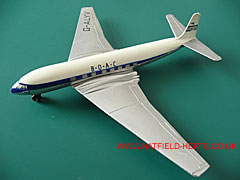
Dinky Toys Comet I (No.702) – bearing registration G-ALYV. 'Yoke Victor' was the eighth Comet built at Hatfield and made its first flight on 9 April 1952. It demonstrates the dangers of using real aircraft markings for children's toys. Tragically, '6008' (original delivered from Hatfield as G-ALYU but changed to G-ALYV by BOAC later) was the first Comet to disintegrate in mid-air. This was due to a failure of the tailplane rather than the problem of metal fatigue at the corners of square windows, which occurred later in other Comet crashes. Operated by BOAC on the Singapore to London route as Flight 783 / 057, it took off from Calcutta, India enroute to Delhi on 2 May 1953. Shortly after taking off into a violent storm, radio contact was lost and parts of aircraft were seen falling from the sky. All passengers and crew were lost (42 according to one source, 43 according to another). The diecast version is shown above and with its box below – having the original packaging makes it more valuable to collectors. However, please note that there are companies that produce replica boxes and less reputable individuals may be using these.
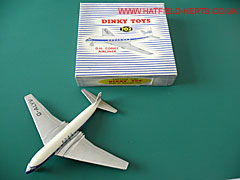
Dinky Toys later reissued the Comet as No.999, as the February 1956 ad below shows. Not surprisingly, the registration has changed from the ill-fated G-ALYV to G-ALYX. G-ALYX (6010) had made its first flight from Hatfield on 9 July 1952, and was delivered to BOAC later that month. It returned to Hatfield for prolonged engine running tests before going to the Royal Aircraft Establishment at Farnborough. It was scrapped there in June 1955.
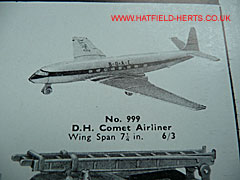
Back to: Hobbies and Collections